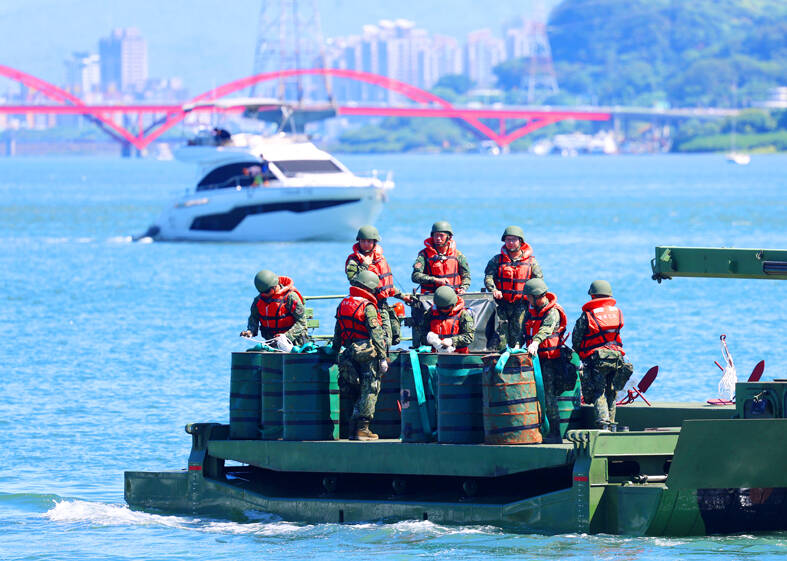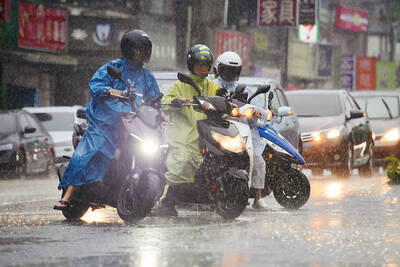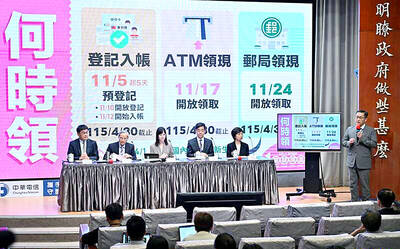The Han Kuang exercises, Taiwan’s largest annual military drills, began yesterday, with experts saying that the extended 14 days of war games were in response to China’s increasing “gray zone” activities and its potential to carry out a full-scale invasion of Taiwan.
This year’s exercises started with around-the-clock computer-aided war games, using the US-built Joint Theater Level Simulation platform.
The live-fire component of the exercises is to be held from July 9 to 18.

Photo: CNA
The drills are to create scenarios in which Chinese People’s Liberation Army (PLA) military exercises escalate into an attack on Taiwan, said Major General Tung Chi-hsing (董冀星), director of the Ministry of National Defense’s joint operations planning division.
The Han Kuang exercises would also simulate PLA “gray zone” activities, which are provocative or aggressive actions that fall just short of an open conflict, Tung told a news conference on Wednesday.
Democratic Progressive Party Legislator Wang Ting-yu (王定宇) on Friday said that the public used to think that a first strike by China would likely come in the form of a missile attack.
However, it is more realistic to think that a first strike would involve maritime militia vessels, sand dredgers and drones, which are commonly used in “gray zone” operations, he said.
Wang, a member of the legislature’s Foreign Affairs and National Defense Committee, said the military has to consider how to deal with situations that go beyond traditional force-on-force confrontations.
These include how to respond to “gray zone” activities within the bounds of international law, while preventing Chinese military drills from escalating into a full-scale invasion, he said.
Such complex scenarios require detailed planning and simulation, making the war games more time-consuming, he said.
Su Tzu-yun (蘇紫雲), director of the Division of Defense Strategy and Resources at the Institute for National Defense and Security Research, expressed similar views, saying that the Han Kuang drills were likely extended this year from eight days to two weeks to facilitate more scenarios involving “gray zone” tactics.
When the PLA is conducting its naval and air patrols around Taiwan, it usually deploys six to 10 warships, Su said, adding that if each of them were equipped with vertical launching systems, there could be about 500 land-attack cruise missiles ready to strike targets across Taiwan within three minutes.
That would leave defense forces with even less response time than if Dongfeng (East Wind, 東風) missiles were launched across the Taiwan Strait from China, he said.
That makes simulating such scenarios critically important, particularly as PLA drills near Taiwan have become more frequent in the past few years, he added.
Minister of National Defense Minister Wellington Koo (顧立雄) in a recent legislative hearing said this year’s Han Kuang exercises would be based on a hypothetical invasion by the PLA in 2027, Su said.
That year would mark several milestones in China, such as the 100th anniversary of the PLA’s founding, the start of Chinese President Xi Jinping’s (習近平) fourth term in office and the 12th year of Xi’s military reforms, he said.
This year’s exercises would test how the Ministry of National Defense would respond in the event of a 2027 invasion and assess any shortcomings in the armed forces’ readiness and arsenal of weapons, Su said.

The combined effect of the monsoon, the outer rim of Typhoon Fengshen and a low-pressure system is expected to bring significant rainfall this week to various parts of the nation, the Central Weather Administration (CWA) said. The heaviest rain is expected to occur today and tomorrow, with torrential rain expected in Keelung’s north coast, Yilan and the mountainous regions of Taipei and New Taipei City, the CWA said. Rivers could rise rapidly, and residents should stay away from riverbanks and avoid going to the mountains or engaging in water activities, it said. Scattered showers are expected today in central and

COOPERATION: Taiwan is aligning closely with US strategic objectives on various matters, including China’s rare earths restrictions, the Ministry of Foreign Affairs said Taiwan could deal with China’s tightened export controls on rare earth metals by turning to “urban mining,” a researcher said yesterday. Rare earth metals, which are used in semiconductors and other electronic components, could be recovered from industrial or electronic waste to reduce reliance on imports, National Cheng Kung University Department of Resources Engineering professor Lee Cheng-han (李政翰) said. Despite their name, rare earth elements are not actually rare — their abundance in the Earth’s crust is relatively high, but they are dispersed, making extraction and refining energy-intensive and environmentally damaging, he said, adding that many countries have opted to

People can preregister to receive their NT$10,000 (US$325) cash distributed from the central government on Nov. 5 after President William Lai (賴清德) yesterday signed the Special Budget for Strengthening Economic, Social and National Security Resilience, the Executive Yuan told a news conference last night. The special budget, passed by the Legislative Yuan on Friday last week with a cash handout budget of NT$236 billion, was officially submitted to the Executive Yuan and the Presidential Office yesterday afternoon. People can register through the official Web site at https://10000.gov.tw to have the funds deposited into their bank accounts, withdraw the funds at automated teller

CONCESSION: A Shin Kong official said that the firm was ‘willing to contribute’ to the nation, as the move would enable Nvidia Crop to build its headquarters in Taiwan Shin Kong Life Insurance Co (新光人壽) yesterday said it would relinquish land-use rights, or known as surface rights, for two plots in Taipei’s Beitou District (北投), paving the way for Nvidia Corp to expand its office footprint in Taiwan. The insurer said it made the decision “in the interest of the nation’s greater good” and would not seek compensation from taxpayers for potential future losses, calling the move a gesture to resolve a months-long impasse among the insurer, the Taipei City Government and the US chip giant. “The decision was made on the condition that the Taipei City Government reimburses the related